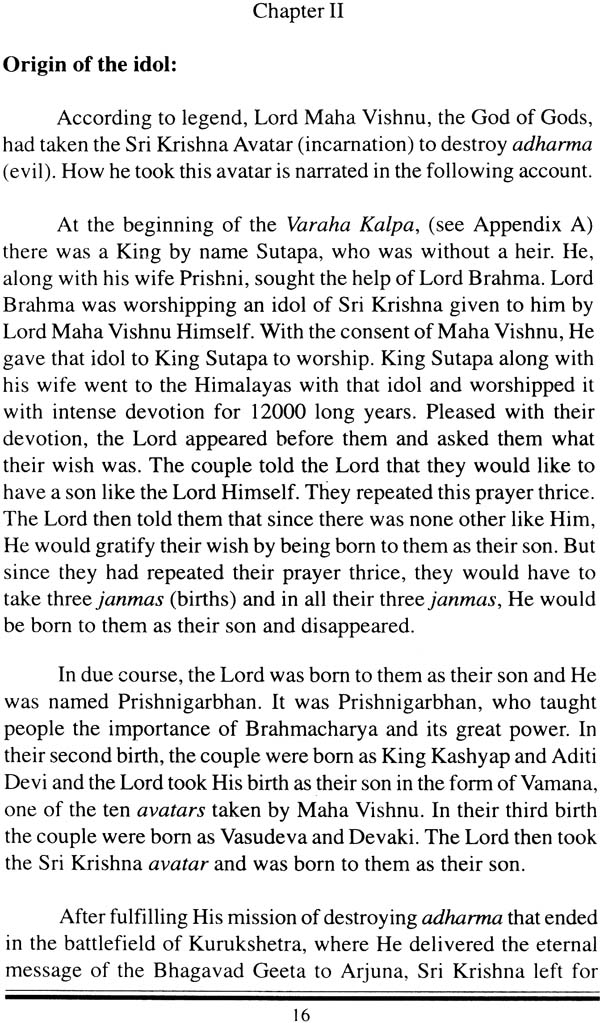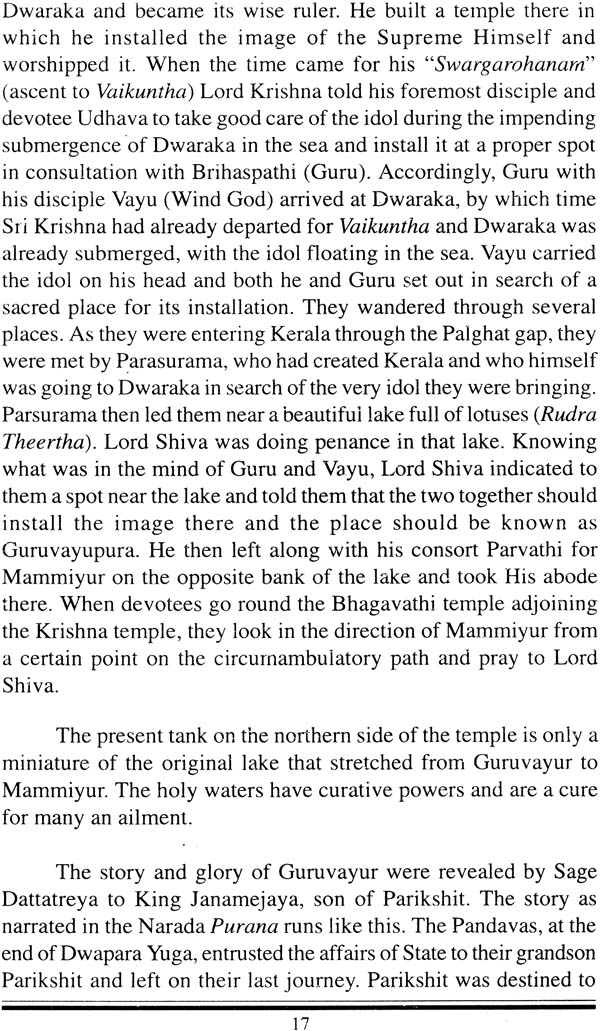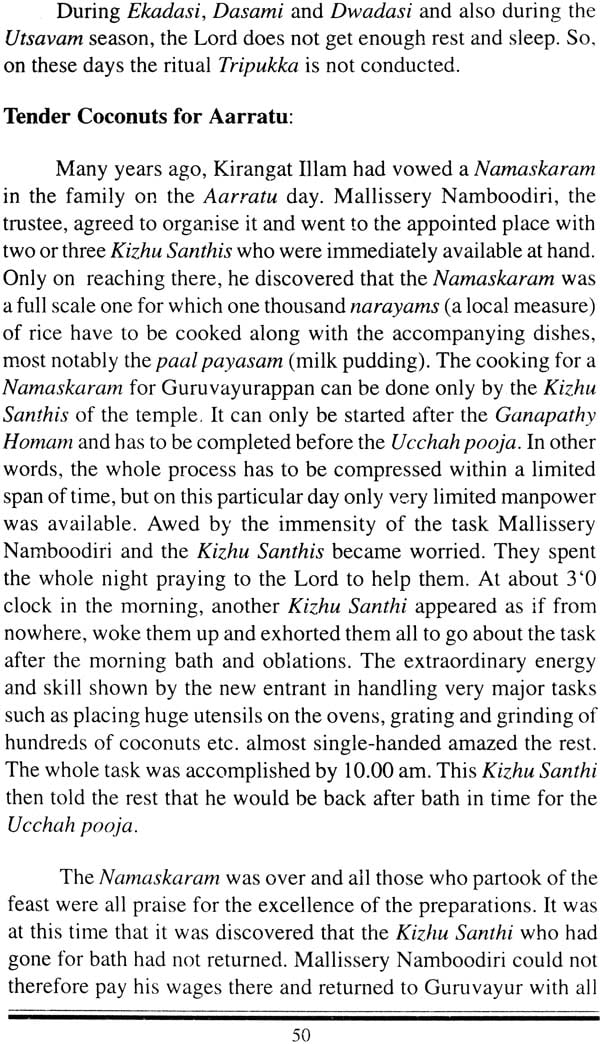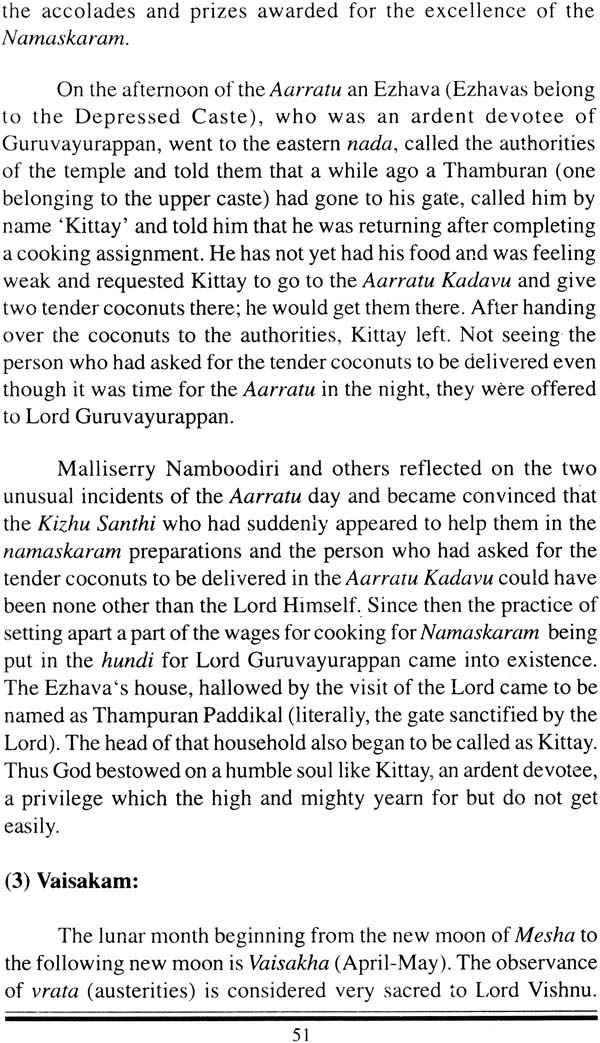
Guru-Pavana-Puram Sri Guruvayur Temple
Book Specification
| Item Code: | IDK778 |
| Author: | G.H. Ananthanarayanan |
| Publisher: | Bharatiya Vidya Bhavan |
| Language: | English |
| Edition: | 1999 |
| Pages: | 80 (9 Color Illustrations) |
| Cover: | Paperback |
| Other Details | 8.5 inch x 5.5 inch |
| Weight | 140 gm |
Book Description
The book, "Mohana Tejas" or "Guruvayurappan", written by Sri T.Shankaran Nambidi, a great devoted of Guruvayurappan, about fifty years ago came to my hands in July last when I was on a holiday in Kerala. Thought struck me that an English version of it might be of use to the thousands of pilgrims from outside Kerala who flock to Guruvayur temple, not knowing the customs and practices in the temple there, but carried solely by an intense faith in Lord Guruvayurappan. I felt that some knowledge and understanding of these things might help them to savour better the spiritual delights of Guruvayur and make their life more meaningful and satisfying. But it was not until February 1999 that I could put pen to paper when I had all the time and quietude to work on it in far away Muscat.
As I started working on it, I began to feel that it would be a waste of effort, as many books might already have written and published on the subject by people who are much more qualified than I. I then felt that a more useful publication might be some kind of a hand-book, which will give in brief the salient aspects of the temple. As a proceeded on these lines I found that I needed more information than what the book "Mohan Tejas" contained. My occasional visit to Guruvayur had equipped me with a certain amount of information, but I needed more, particularly in areas such as details of rituals and offerings in the temple. But a place like Muscat is not exactly where one could look for books on a subject like this, but, as luck would have it, I stumbled upon a copy of the well-researched book, "Sri Krishna, Lord of Guruvayur" by Sri K.R. Vaidyanathan. I have used some of the information contained in this book for my handbook and would strongly recommend it for any detailed study of the subject. I had the benefit of the manuscript of the book read by Sri Chakkyar Rajan of Mumbai, who made some valuable suggestions, which I have incorporated. I hereby acknowledge my gratitude to the authors of both the books and to Sri Chakkyar Rajan. I would also like to record here my appreciation for the help rendered to me by the following:
1. Ms. Nilina Menon for rendering an English translation of some portions of the book "Mohana Tejas".
2. My daughter, Usha Raman for helping me with the typescript on the computer and checking details.
3. My son-in-law, C.B. Raman for helping me in bringing out this publication.
Keeping in view the nature of the subject matter of the book, I have taken the opportunity to include a small chapter of Faith and Idol Worship and the role of rituals, festivals, namasankirtana etc. in the Hindu way of life.
I am only too well aware that what has been written is neither original nor comprehensive; nor may it create any spiritual fervour. It only seeks to purvey some information about the most well known temple of Kerala. If it helps any one in any away, it wait have served its purpose.
This booklet is dedicated to the memory offering my mother N.A. Parvathi Ammal (popularly known as Palu Mami in Wadakanchery, Kerala) and my wife, Kamala, who were ardent devotees of Lord Guruvayurappan.
I cannot conclude this Preface without offering my respects and obeisance to His Holiness Sri Kanchi Kamakoti Peetadhipathi Jagadguru Sri Jayendra Saraswathi Swamigal, who has been kind enough to bless my humble effort with a 'Sri Mukham' (Benedictary message).
When Shri G.H. Ananthanarayanan told me that he has written a book on the Guruvayur temple and that to a Hand-Book my immediate reaction was, "Is one more necessary?" I soon revised my opinion. On going through the book, I found it to be not only useful but also necessary, especially for those from outside Kerala who may not be familiar with the temples there.
In the brief space of about 70 pages, the author has given a synoptic view of the origin of the idol in the Guruvayur Temple, the rituals and festivals there and various other aspects in minute and meticulous detail. More than that, in a few deft strokes, he has dwelt on the need for faith in a God, the meaning and significance of idol worship and the role of rituals and religious festivals in sustaining Hinduism and the Hindu way of life. The role of Nama Sankirtanam has also been brought into sharp focus. In fact, the author has gone beyond the bounds of the unpretentious title of Hand-Book which he has chosen to give to the book. In doing so, he has done a signal service to the followers of the Hindu faith.
It is not only that the author has encapsulated into this miniature book all the essentials centering around Guruvayur Temple but has also covered myths, history, tradition and beliefs spanning over five millennia, which is no mean task. I am reminded of a famous Sanskrit sloka of Kalidasa which has become an idiom and he has indeed performed the near impossible!
Verily has it been said by our sages and seers that Bhakti Marga is the one most suited for ordinary mortals to attain salvation. And there are few places of worship like the Guruvayur Temple which provides the perfect ambience for a Bhakti Margi. The present book is therefore, a useful and necessary addition to the cornucopia of literature of the Guruvayur Temple.
A word about the author becomes relevant here. Though Shri Ananthanarayanan worked in the Government of India as a Class I officer, his perceptions were invariably oriented towards the community. His first love has been propagation of knowledge. The North Bombay Welfare Society's High School in Ghatkopar, Mumbai is a standing testimony to the untiring efforts put in by him and his colleagues on the Governing Body of the School for the causes of education. Shri Ananthanarayanan is a founding Member of the School and has been its moving spirit right from its inception in 1962 as President of the parent Society for 35 out of 37 years of its existence and as Chairman of the School Committee for 25 years, and continues to be at the helm of affairs of both.
The school has more than 3000 students on its rolls and excels not only in academics but also in the all-round development of students. It redounds to the credit of Shri Ananthanarayanan that he has created a motivated team to run the school affairs.
Shri Ananthanarayanan has championed the causes of pre-1986 pensioners. He had also championed the cause of Central Government employees for grant of House Building advances for purchases of flats and succeeded. But for this facility many of these employees might not have found it possible to purchase flats in places like Mumbai and perhaps even in smaller towns. The Indian Coffee Workers' Cooperative Society consisting of nearly 500 workers look upon him as a pillar of strength and for wise guidance for the last about 10 years. Under his guidance, the Society has made considerable strides, including attitudinal changes.
I consider it a great privilege to have been given the opportunity to write this Foreword. I am sure that the readers the world over will benefit by reading this small book of knowledge and wisdom, Small is always beautiful.
You deserve the inner and outer harmony that brings joy and purposefulness to life. This state of mind will not, however, come out of the blue. Inner peace will come out of the way you live your life the values you honor, the choices you make and the actions you take. Acquiring ever-deeper inner peace is a life-long process, because you are continually evolving and changing.
The way you choose to look at things and react to them determines how you experience each moment. Attitude is the mother and father of your emotions. You can choose between inner turmoil and inner peace.
You start the day with a positive attitude and as a result your experience for the most part is satisfying. If outside pressures or events threaten your peace of mind, you can reaffirm your earlier choice. When negative thoughts threaten to drag you downhill, you can choose to reverse their direction. You can drain their power immediately by occupying your mind with positive reflections. It is a lot easier to change a negative attitude when you have some idea of its origins.
Each time you gain serenity by changing an attitude, it is a significant accomplishment. And the more you put your power of choice to work this way, the easier it gets.
You can quickly regain your perspective by thinking about the vastness of the universe; by thanking about the billions of other people in the world, each leading a life as unique and important as your own, by thinking about the grandeur of God's largest plan.
There are days when you start with a positive, affirmative outlook and then suddenly your attitude changes for the worse; you become nervous and irritable and begin to feel depressed. You can then choose to take a number of actions singly or in combination to change your focus. Sometimes, all it takes is a phone call to an understanding friend or an exercise session. Many people meditate to become centered again. You can read or listen to an inspirational message or simply repeat a soothing mantra.
One of the quickest and most effective ways to alter an attitude is no take a moment literally to count your blessings. When you pause to make a mental or written list of all you have to be grateful for, changes are that you will realize immediately that things are not as bad as they first seemed. Your blessings need not necessarily be along material lines or even tangible. But if you can honesty look at the reality of your life, you are bound to find much to be thankful for.
When you are determined to change a negative attitude but find it difficult to do so on your own, you can turn your thoughts to God. You will be better able to maintain a positive attitude when God is on your mind.
Your attitudes, as much as anything else, define your experiences, shape your emotional destiny and determine your level of serenity. There are choices you can make, actions that you can take to bring it about. Today is an ideal time to start.
| Chapter No. | Topic |
| Benedictary Message from His Holiness Sri Kanchi Kamakoti Peetadhipathi Jagadguru Sri Jayendra Saraswathi Swamigal | |
| Author's Preface | |
| Foreword by Shri S. Ganesan, I.E.S. (Redt.), Chairman, Pestom Sagar Citizens' Forum | |
| A Handy Hand-book An Appreciation by Chakyar Rajan | |
| I | Introduction |
| II | Origin of the Idol |
| III | Faith and Idol Worship |
| IV | Rituals |
| V | Offerings |
| VI | Temple Priests |
| VII | Festivals |
| VIII | Bhagavathi Temple |
| IX | Temple Well |
| X | Devotion |
| XI | Some Legends |
| XI | Ode to an Unknown Devotee |
| Appendices | |
| Appendix A | Time in relation to Brahma's Life |
| Appendix B | Belikallus (Altars) |
| Appendix C | Details of Offerings |
| Appendix D | Lodging Facilities |









